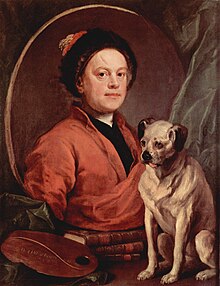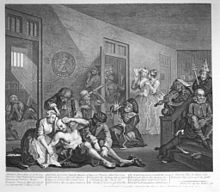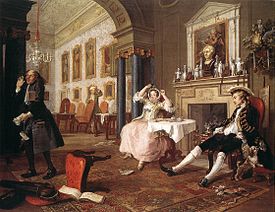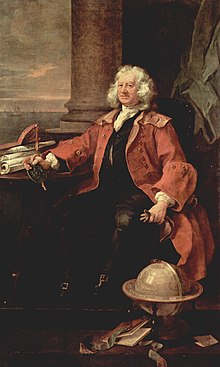This is an old revision of this page, as edited by TransUtopian (talk | contribs) at 19:52, 21 September 2006 (rvv). The present address (URL) is a permanent link to this revision, which may differ significantly from the current revision.
Revision as of 19:52, 21 September 2006 by TransUtopian (talk | contribs) (rvv)(diff) ← Previous revision | Latest revision (diff) | Newer revision → (diff)
William Hogarth (November 10, 1697 – October 26,1764) was a major English painter, engraver, pictorial satirist, and editorial cartoonist who has been credited as a pioneer in western sequential art. His work ranged from excellent realistic portraiture to Comic strip-like series of pictures called “modern moral subjects.” Much of his work, though at times vicious, poked fun at contemporary politics and customs.
Early years
The son of a poor schoolteacher and textbook writer, William Hogarth was born at Bartholomew Close in London on November 10, 1697. In his youth he was apprenticed to the silver-plate engraver Ellis Gamble in Leicester Fields, where he learned to engrave shopcards and the like. Young William also took a lively interest in the street life of the metropolis and the London fairs, and amused himself by sketching the characters he saw. At around the same time, his father, who had opened an unsuccessful Latin-speaking coffee house at St John's Gate, was imprisoned for debt in Fleet Prison for five years. Hogarth never talked about the fact. By April 1720 he was engraver on his own account, at first engraving coats of arms, shop bills, and designing plates for booksellers. Early satirical works included an Emblematical Print on the South Sea Scheme (c.1721).
The South Sea Scheme is about the disastrous stock market crash of 1720 known as the South Sea Bubble, where many English people lost a great deal of money. In the bottom left corner, he shows Protestant, Catholic and Jewish figures gambling, while in the middle there is a huge merry-go-round like machine, which people are getting on to ride. At the top is a goat, written below which is "Who'l Ride" and this shows the stupidity of people in following the crowd in buying South Sea Company stock, a company which spent more time issuing stock than actually producing anything. The people are scattered around the picture with a real sense of disorder, which represented the confusion. The progress of the well dressed people towards the ride in the middle shows how foolish some people could be, which is not entirely their own fault.
Other early works include The Lottery (1724); The Mystery of Masonry brought to Light by the Gormogons (1724); A Just View of the British Stage (1724); some book illustrations; and the small print, Masquerades and Operas (1724). The latter is a satire on contemporary follies, such as the masquerades of the Swiss impresario John James Heidegger, the popular Italian opera singers, John Rich's pantomimes at Lincoln's Inn Fields, and last not least, the exaggerated popularity of Lord Burlington's protégé, the architect and painter William Kent. In 1726 Hogarth prepared twelve large engravings for Samuel Butler's Hudibras. These he himself valued highly, and are among his best book illustrations.
In 1727–1728 he was hired by Joshua Morris, a tapestry worker, to prepare a design for the Element of Earth. Morris, however, having heard that he was "an engraver, and no painter", declined the work when completed, and Hogarth accordingly sued him for the money in the Westminster Court, where, on the May 281728, the case was decided in Hogarth's favour. The following years he turned his attention to the production of small "conversation pieces" (i.e., groups in oil of full-length portraits from 12 to 15 in. high). Among his efforts in oil between 1728 and 1732 were The Fountaine Family (c.1730); The Assembly at Wanstead House; The House of Commons examining Bambridge; and several pictures of the chief actors in John Gay's popular The Beggar's Opera. One of his masterpieces of this period is the depiction of an amateur performance of John Dryden's The Indian Emperor, or The Conquest of Mexico (1732–1735) at the home of John Conduitt, master of the mint, in St George's Street, Hanover Square.
On the March 23, 1729 he was married to Jane Thornhill, daughter of artist Sir James Thornhill.
Notable engravings between 1726 and 1732 are the Large Masquerade Ticket (1727), another satire on masquerades, and possibly the print of Burlington Gate (1731), evoked by Alexander Pope's Epistle to Lord Burlington, and defending Lord Chandos, who is therein satirized. This print gave great offence, and was suppressed. (However, it is no longer attributed to Hogarth by some modern authorities.)
Painter and engraver of modern moral subjects
Hogarth lived in an age when artwork became immensely commercialized, something no longer just exhibited in churches and the homes of connoisseurs, but viewed in shopwindows, taverns and public buildings and sold in printshops. Old hierarchies broke down, and new forms began to flourish: the ballad opera, the bourgeois tragedy, and especially, a new form of fiction called the novel with which authors such as Henry Fielding had great success. Therefore, by that time, Hogarth hit on a new idea: "painting and engraving modern moral subjects ... to treat my subjects as a dramatic writer; my picture was my stage", as he himself remarked in his manuscript notes. To be sure, there were earlier artists that had depicted ordinary life, but Hogarth's moralizing was indeed revolutionary.
Harlot's and Rake's Progress
In 1731, he completed the earliest of the series of moral works which first gave him his position as a great and original genius. This was A Harlot's Progress, first as paintings (now lost), and then published as engravings. In its six scenes, the miserable fate of a country girl who began a prostitution career in town is traced out remorselessly from its starting point, the meeting of a bawd, to its shameful and degraded end, the whore's death of venereal disease and the following merciless funeral ceremonial. The series was an immediate success, and was followed in 1735 by the sequel A Rake's Progress showing in eight pictures the reckless life of Tom Rakewell, the son of a rich merchant, who wastes all his money on luxurious living, whoring and gambling, and ultimately finishes his life in Bedlam.

Hogarth's other prints in the 1730s include A Midnight Modern Conversation (1733), Southwark Fair (1733), The Sleeping Congregation (1736), Before and After (1736), Scholars at a Lecture (1736), The Company of Undertakers (Consultation of Quacks) (1736), The Distrest Poet (1736), The Four Times of the Day (1738), and Strolling Actresses dressing in a Barn (1738).
Four Times of the day
The Four Times of the day series shows his version of the traditional times of the day theme in art; of events taking place at morning, noon, afternoon and night. In Morning, there is a wealthy woman on the way to church, who avoids making eye contact with the couple on the right or the beggar below her, speaking of the hypocrisy of some church goers by acting pious but ignoring their fellow people. The next print, Noon, continues the theme, with well dressed people exiting the church on the right, while there are poorer people suffering on the left, a line in the middle of the picture in the road actually dividing the two classes. It shows clearly the gap in society between the upper and lower classes. While the rich look ridiculous and haughty in their fine costumes, the poor are more concerned with food and sex. In fact, the main building in 'Noon' from which people are emerging is a church. It is a rare representation of the, now demolished, Greek Church in Hogs Lane which later became Greek Street. It was built by London's 17th century Greek community and, in 1682, was taken over as a French Protestant Church by the Huguenots but was always known as 'L'eglise des Grecs'. The engraving also shows what looks like an African Londoner on the left, with his arms round the lady holding the tray.
Marriage à-la-mode

In 1743–1745 Hogarth painted the six pictures of Marriage à-la-mode (National Gallery, London), a pointed skewering of upper class 18th century society. This moralistic warning shows the miserable tragedy of an ill-considered marriage for money. This is regarded by many as his finest project, certainly the best example of his serially-planned story cycles.
In Marriage à-la-mode, Hogarth challenges the ideal view that the rich live virtuous lives & gives heavy satire to the notion of arranged marriages. In each piece, he shows the young couple and their acquaintances and family at their worst: having affairs, drinking, gambling, fornicating and engaging in numerous other vices and sins. In the first of the series, he shows an arranged marriage between a Count and Countess. In the second, there are signs that the marriage has already begun to break down. The husband and wife appear exhausted and disinterested in one another, amidst evidence of overindulgence the night before. An accountant leaves with a stack of unpaid bills, nimbly sidestepping an overturned chair (a recurring motif in the series).
The personalities and interests of the newlyweds, as well as their status in society, are revealed by the personal effects embellishing the scene, such as playing cards, a book of music and the likely sexually suggestive artwork hidden underneath the curtain in the other room. The third in the series, The Quack Doctor, shows the Count visiting an avaricious and seedy doctor with two women, to ascertain which of them gave him a sexual disease. Later, the Count catches his wife with her lover, and is fatally wounded by the scoundrel. Sadly, as she comforts the stricken man, the murderer in his nightshirt makes a hasty exit through her bedroom window.
Finally the Countess poisons herself in her grief and poverty-stricken widowhood. The loss of their wealth and potential happiness is a clear moral lesson, exemplified by the sparse quarters of this final image (a stark contrast to the luxurious environs of the first one when the marriage was arranged). In these grimly reduced circumstances, her father removes her wedding ring as she swoons, appearing to think only of the monetary value. Hogarth thus gives a gloomy view of what he perceives to be the life of the upper classes, as well as the ultimate costs of a loveless arranged marriage.
These admirable pictures were at first poorly received by the public, to the great disappointment of the artist. He sold them to a Mr. Lane of Hillington for one hundred and twenty guineas. The frames alone had cost Hogarth four guineas each. So his initial remuneration for painting this valuable series was but a few shillings more than one hundred pounds. From Mr. Lane's estate, they became the property of his nephew, Colonel Cawthorn, who very highly valued them. In the year 1797 they were sold by auction at Christie's, Pall Mall, for the sum of one thousand guineas; the liberal purchaser was the late Mr. Angerstein. They now belong to the government, and are among the most attractive objects in the National Gallery in London.
Portraits

Hogarth was also a popular portrait painter. In 1746 he painted actor David Garrick as Richard III, for which he was paid £200, “which was more,” he wrote, “than any English artist ever received for a single portrait.” In the same year a sketch of Simon Fraser, 11th Lord Lovat, afterwards beheaded on Tower Hill, had an exceptional success. Hogarth's truthful, vivid full-length portrait of his friend, the philanthropic Captain Coram (1740; formerly Thomas Coram Foundation for Children, now Foundling Museum), and his unfinished oil sketch of a Shrimp Girl (National Gallery, London) may be called masterpieces of British painting.
Later years
Notable Hogarth engravings in the 1740s included The Enraged Musician (1741), the six prints of Marriage à-la-mode (1745; executed by French artists under Hogarth's inspection), The Stage Coach or The Country Inn Yard (1747),
Industry and Idleness

In the twelve prints of Industry and Idleness (1747) Hogarth shows the progression in the lives of two apprentices, one who is dedicated and hard working, the other idle which leads to crime and his execution. This shows the work ethic of Protestant England, where those who work hard get rewarded, such as the industrious apprentice who becomes Sheriff (plate 8), Alderman (plate 10) and finally the Lord Mayor of London in the last plate in the series. The idle apprentice, who begins with being "at play in the church yard" (plate 3), ends up "in a Garrett with a Common Prostitute" (plate 7) and "executed at Tyburn" (plate 11) The idle apprentice is sent to the gallows by the industrious apprentice himself.

The Gate of Calais (1749) was produced soon after his return from a visit to France. Horace Walpole wrote that Hogarth had run a great risk to go there since the peace of Aix-la-Chapelle,
he went to France, and was so imprudent as to be taking a sketch of the drawbridge at Calais. He was seized and carried to the governor, where he was forced to prove his vocation by producing several caricatures of the French; particularly a scene of the shore, with an immense piece of beef landing for the lion d'argent, the English inn at Calais, and several hungry friars following it. They were much diverted with his drawings, and dismissed him.
Back home, he immediately executed a painting of the subject (1748; now in Tate Britain), in which he unkindly represented his enemies, the Frenchmen, as cringing, emaciated and superstitious people, while the enormous sirloin of beef arrives, destined for the said inn as a symbol of British prosperity and superiority.
In 1745 Hogarth painted a self-portrait with his dog (now also in Tate Britain), which shows him as a learned artist supported by volumes of Shakespeare, Milton and Swift. In 1749, he represented the somewhat disorderly English troops on their March to Finchley (formerly Thomas Coram Foundation for Children, now Foundling Museum).
Beer Street and Gin Lane
Later important prints include his pictorial warning of the unpleasant consequences of alcoholism in Beer Street and Gin Lane (1751) Hogarth engraved Beer street to show a happy city drinking the 'good' beverage of English beer, versus Gin Lane that showed what would happen if people started drinking gin which, as a harder liquor, would cause more problems for society. People are shown as healthy, happy and hard working in Beer Street, while in Gin lane they are scrawny, lazy and acting carelessly, such as the drunk woman at the front who reaches for a snuff box and in doing so, drops her baby. The prints were published partly to support the 1751 Gin Act. The magistrate, Henry Fielding, supposedly informed Hogarth of these proceedings, to help with propaganda for a Gin Act, which his work An Enquiry into the Causes of the Late Increase of Robbers, and Related Writings hoped to achieve.
Four Stages of Cruelty

Other prints were his outcry against inhumanity in The Four Stages of Cruelty (1751); a series which Hogarth intended to show some of the terrible habits of criminals. In the first picture there are scenes of torture of dogs, cats and other animals. In the second it shows one of the characters from the first painting, Tom Nero, has now become a coach driver, and his cruelty to his horse caused it to break its leg. In the third painting Tom is shown as a murderer, with the woman he killed lying on the ground, while in the fourth, titled Reward of Cruelty, the murderer is shown being dissected by scientists after having being executed. Hogarth is thus using the series to say what will happen to people who carry on in this manner. This shows what crimes people were concerned with in this time, the method of execution, and the dissection reflects upon the 1752 Act of Parliament which had just being passed allowing for the dissection of executed criminals who had been convicted for murder. It shows his reaction against the cruel treatment of animals which he saw around him, that he wished could be stopped.
Others were his satire on canvassing in his Election series (1755–1758); his ridicule of the English passion for cockfighting in The Cockpit (1759); his attack on Methodism in Credulity, Superstition, and Fanaticism (1762); his political anti-war satire in The Times, plate I (1762); and his pessimistic view of all things in Tailpiece, or The Bathos (1764).
Less successful painter of historical subjects
During a long period of his life, Hogarth tried to achieve the status of history painter, but had no great success in this field. Examples of his history pictures are the two Biblical subjects (The Pool of Bethesda and The Good Samaritan) executed in 1736–1737 for St Bartholomew's Hospital; Moses brought before Pharaoh's Daughter painted for the Foundling Hospital (1747; formerly at the Thomas Coram Foundation for Children, now in the Foundling Museum); Paul before Felix (1748) at Lincoln's Inn; and his altarpiece for St. Mary Redcliffe, Bristol (1756). In 1757, however, he was appointed Serjeant Painter to the King.
Parodic borrowings from the Old Masters
When analyzing the work of the artist as a whole, Ronald Paulson, the modern authority on Hogarth, sees an accomplished parodist at work, and a subversive. He says, "In A Harlot's Progress, every single plate but one is based on Dürer's images of the story of the Virgin and the story of the Passion." In other works, he parodies Leonardo da Vinci's Last Supper. According to Paulson, Hogarth is subverting the religious establishment and the orthodox belief in an immanent God who intervenes in the lives of people and produces miracles. Indeed, Hogarth was a Deist, a believer in a God who created the universe but takes no direct hand in the lives of his creations. Thus, as a "comic history painter", he often poked fun at the old-fashioned, "beaten" subjects of religious art in his paintings and prints. Hogarth also rejected Lord Shaftesbury's then current ideal of the classical Greek male in favor of the living, breathing female. He said, "Who but a bigot, even to the antiques, will say that he has not seen faces and necks, hands and arms in living women, that even the Grecian Venus doth but coarsely imitate."
The Analysis of Beauty
Hogarth also wrote and published his ideas of artistic design in his book The Analysis of Beauty (1753). In it, he professes to define the principles of beauty and grace which he, a real child of Rococo, saw realized in serpentine lines.
Death
Hogarth died in London on October 26, 1764 and was buried at St. Nicholas' Churchyard, Chiswick Mall, Chiswick, London. His friend the actor David Garrick wrote the inscription on his tombstone.
Influence
His satirical engravings are often considered an important ancestor of the comic strip.
Stravinsky's opera The Rake's Progress, with libretto by W. H. Auden, was inspired by Hogarth's series of paintings of that title
Physical links
- Hogarth's original paintings for A Rake's Progress can be seen in the painting room at the Sir John Soane Museum.
- Hogarth's house is now a museum (free entry) and can be visited at Hogarth Lane, Great West Road, Chiswick, London, W4 2QN. For more information see Hidden London. One of London's best known road junctions is named after Hogarth – the Hogarth Roundabout at the junction of the A316 Great Chertsey Road and the A4 Great West Road.
References
- Peter Quennell, Hogarth's Progress (London, New York 1955)
- Frederick Antal, Hogarth and His Place in European Art (London 1962)
- David Bindman, Hogarth (London 1981)
- Ronald Paulson, Hogarth's Graphic Works (3rd edn, London 1989)
- Ronald Paulson, Hogarth, 3 vols. (New Brunswick 1991-93)
- Jenny Uglow, Hogarth: A Life and a World (London 1997)
- Frédéric Ogée and Peter Wagner, eds., William Hogarth: Theater and the Theater of Life (Los Angeles, 1997)
- Hans-Peter Wagner, William Hogarth: Das graphische Werk (Saarbrücken, 1998)
- David Bindman, Frédéric Ogée and Peter Wagner, eds. Hogarth: Representing Nature's Machines (Manchester, 2001)
See also
External links
- William Hogarth Archives (130 images from the collection of the University of Wales, Lampeter)
- William Hogarth, His work illustrated and appraised
- William Hogarth and 18th-Century Print Culture
- The Site for Research on William Hogarth
- William Hogarth's Realm
- Print series in detail
- Museumsportal Schleswig-Holstein
- Hogarth's The Rake's Progress and other of his works
- Note: Commercial site.